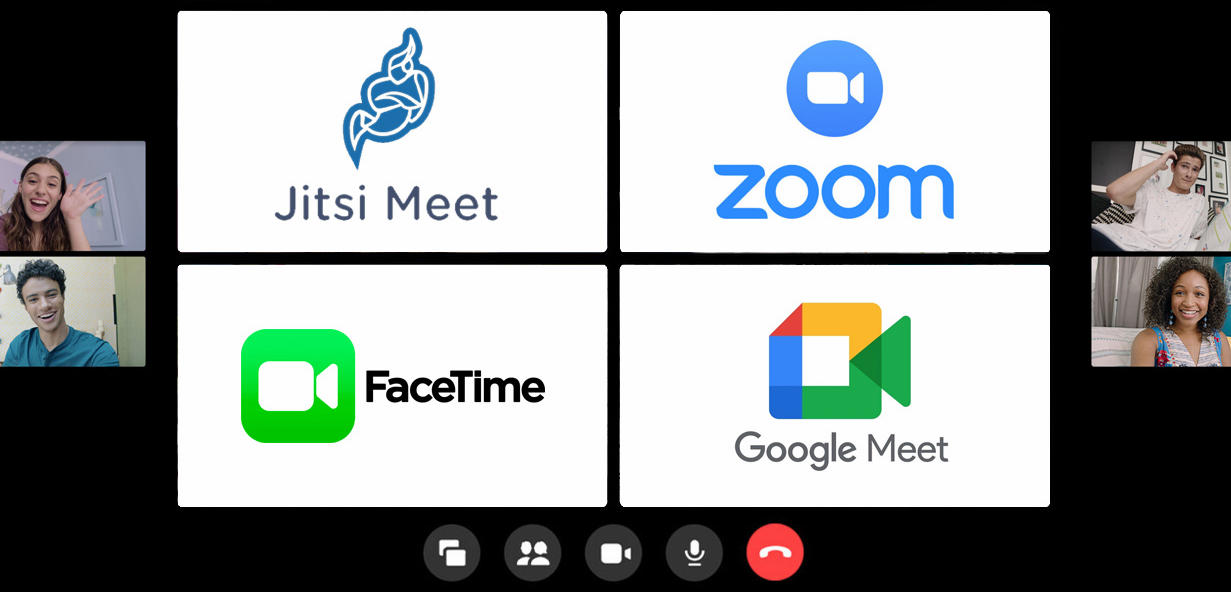10 Best Video Conferencing Applications to Stay Connected During Christmas

Omicron, the latest variant of SARS-CoV-2 and the most contagious to date, is wreaking havoc worldwide in the sixth wave of the COVID pandemic. Either as a measure of protection and personal responsibility or to comply with the government’s restrictions, we fear that Christmas in 2021 will have to be as ‘homemade’ as those in 2020 were. Preferable is to stay healthy, and there will be a time in the future to resume physical contact and get vaccinated, although this would give for another type of article that is out of our way.
In any case, there are other ways to stay connected with family and friends. Even if it is virtually. And we talk about video conferencing applications. They have always been used a lot, but in 2020, due to the confinements, they became the most searched, downloaded, and operated group of software. And this year is almost the same, both for family connection and to cover the needs of telework or study at home that the pandemic has forced to maintain.
Video conferencing applications
If you do not know all the available offers and want to have these applications at hand, we remind you of the ten most interesting for the main desktop and mobile operating systems. All are free, and some are open source and cross-platform.
1. Jitsi
An exciting project, 100% free, open-source, private, and you do not need registration or installation. Jitsi began its journey as a clone of Microsoft’s Messenger, but with multiprotocol support and with time, its development turned towards the field of Skype-style VoIP solutions. It is one of the most potent proposals for workgroups, although it is available for private users.
It includes features like desktop sharing, presentation playback, collaborative document editing, and, of course, video conferencing with integrated chat and a limit of up to 75 participants. To highlight the audio and video quality (based on the WebRTC standard), its security and its privacy policy are genuinely respectful of privacy. Jitsi Meet works on web browsers (preferably Chrome), iOS and Android mobile platforms, and platforms like Slack.
2. Zoom
It left behind some security and privacy issues based on updates and continues to be one of the most used video conferencing applications due to the ease of use of its interface, its fun backgrounds, and its scalability for use on multiple devices. It is a complete video conferencing package aimed at business users, offering an attractive free option.
Users with this type of account can host video conferences for up to 100 participants, although meetings of three or more members are limited to 40 minutes. You can upgrade to a paid plan to remove these restrictions or keep the free one that allows you to make phone calls, record video or audio locally, and share screens with other participants. Zoom can be used via the web, with dedicated applications, browser extensions, and mobile devices using iOS and Android apps.
3. Google Meet – Duo
Google has replaced Hangouts with Meet, a tool born for educational and business segments, and has reached all users. Any Google user can hold group video conferences of up to 250 participants regardless of their subscription level in the commercial G Suite and G Suite for Education solutions. It is available for iOS, Android, and via web browser on any device.
Google offers other video conferencing applications to enhance Hangouts that never finished exploding. More straightforward and more specialized than Meet, Justin Uberti created Google Duo (responsible for the WebRTC communications standard) and was born as an alternative to FaceTime and everything from messaging services. Google expanded its group calling capacity to 32 participants. It works great (especially on Android), offers excellent streaming quality, and is also available for iOS, Chrome OS, and via the web.
4. FaceTime
Apple’s communications app is a preferred option for users of the Cupertino firm. It works through a phone number or an Apple ID and allows you to make video or audio calls simultaneously with up to 32 participants. FaceTime is integrated into the list of recent calls in the Phone app and can also be used from the Contacts.
https://youtu.be/4s1vNywzw-Q
5. Microsoft Teams – Skype
Microsoft is driving Teams as a unified communication and collaboration platform. The evolution of Skype for Business, its business approach is straightforward as it combines persistent chat, file storage, and collaboration and application integration, especially with the Office suite. But it is also used as a video conferencing application and has free versions for all versions of Windows, macOS, iOS, Android, and the web.
Another one available is Skype. Microsoft proprietary software, after acquiring what the best VoIP platform on the market was, allows text, voice, and video communications over the Internet (VoIP), free by voice and video between Skype users from and to anywhere in the world, in addition, to allow special calls to be made at meager cost, between computers and fixed or mobile telephone networks. Works on Windows, macOS, or Linux; Android, Windows Phone, and iOS. It is also compatible with most smart TVs and can be used on consoles like Xbox.
The Skype Meet Now variant allows videoconferences without registering anywhere or downloading and installing any application. All you have to do is enter the Skype Meet Now website and, with one click, generate a link to share with those you want to start a conversation with. They include the possibility of recording calls or sharing the screen with the same limit of participants (50) of the general application.
6. Cisco Webex
CISCO is a name generally associated with commercial business products, generally out of reach for ordinary users. But it also has solutions like Webex, a robust and accessible option for those looking for introductory video conferencing apps. It allows you to host up to 100 participants in a single call for as long as you want. There are no limits to the number of calls you can make, and with a free account, you get 1GB of cloud storage.
Webex allows users in up to 52 countries to use a standard telephone to join any conference. Participants who wish to use their webcams can choose from a website, dedicated desktop applications, or mobile applications for iPhone and Android with their screen-sharing features.
7. Tox
If you are looking for a secure and private alternative that is not part of a company’s business, here is an open-source solution whose forceful definition marks apparent distances from other commercial ones: «Tox is made by people fed up with the existing options that spy on us, they track us down, censor us and prevent us from innovating.”
You may have a lousy interface or confusing setup, but you don’t. Just install qTox (the full-featured app) or uTox (intended for lighter systems) and start chatting. Tox is entirely free and without ads. It offers secure chats, voice calls, video calls, and unlimited screen sharing and file sharing. Tox has Windows, Mac, and Linux versions and mobile versions for iOS and Android.
8. FreeConference
Contrary to its name, it is not a free service by default. It’s a premium paid service that offers a decent free option that can come in handy for primary cases. FreeConference only supports up to 5 video conference participants on the free tier. What makes FreeConference shine is its support for up to 1,000 audio participants to call on the phone.
The service also takes a software-free approach to video calling, allowing most users to connect from just a browser. It also offers mobile applications for iPhone and Android, which are open to free users.
9. Viber
A classic option that offers all the standard features, including group chats, video calls, and stickers. If you change devices often, you will appreciate Viber’s transfer feature that allows calls to be moved to a mobile phone.
Viber features public chats (called Communities) that allow you to connect with others if you don’t have friends to message, and it has games built-in if you want to compete with your friends. Viber doesn’t stand out for any particular reason, but it’s a solid app. To use it on the desktop, you will first need to sign in on your mobile phone to sync the account.
10. Whatsapp – Telegram – Line
We leave the solutions of three great instant messaging applications for last. Although they are not the best video conferencing applications, they also offer these functions. They will indeed be used massively due to their versatility, ease of use, and because they are installed in hundreds of millions of devices. You know them well, and they work directly on messaging clients, including video calls, voice calls, and text messages.
For Line is another well-known messenger (albeit widely used in Asia) that allows you to easily keep up with friends and family. Offers free video calls, voice calls, and text messages for groups. Also, thousands of animated stickers, although most are paid through in-app purchases.

